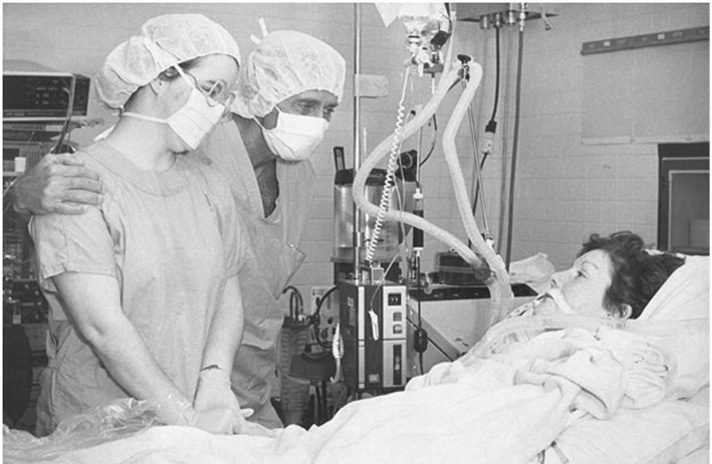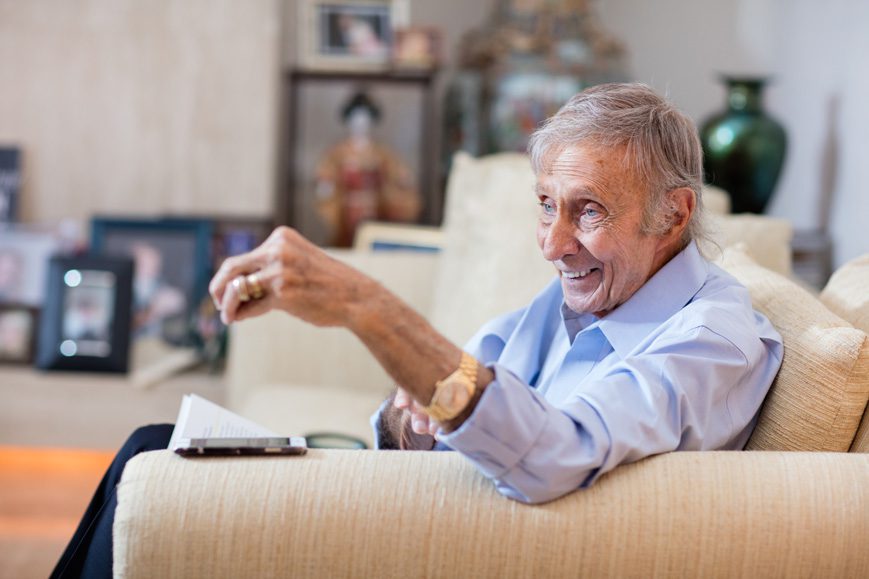Love And Mercy
Hemodilution would forever remain Zuhdi’s most transformative contribution to medical science, but it was far from his last. For when Kirkpatrick had decided to build Zuhdi a lab, he also went a step further: he sent him a partner.
Kirkpatrick recruited U.S. Navy commander and engineer Clark Ritchie to join Zuhdi to build the lab. Ritchie stayed with Zuhdi for seven years at Mercy Hospital. The two lived within a couple of blocks of each other in Nichols Hills, and together, Ritchie and Zuhdi would create the next innovation that would forever change the face of medical science: the Zuhdi-Ritchie artificial bypass heart.
[pullquote]She is the waterfall of my life,” Zuhdi says simply. “Without her, there is no greenery.[/pullquote]A version of the plastic heart is now preserved at the Oklahoma History Center. But its journey began, appropriately, with a dog named Mercy.
As the first recipient of the artificial heart, Mercy the Dog gained instant fame across the world in 1963. Mercy Hospital and Zuhdi’s lab were once again inundated with reporters and scientists from across the globe who had come to see the remarkable canine.
“Oklahoma City became so famous! It was amazing,” Zuhdi says. “Because Mercy made history in the world, you know.”
The dog was cared for by Sister Mary Alvera in the basement lab of Mercy Hospital – the same nun who would introduce Zuhdi to Annette, the woman who would become his wife.
“She became a special RN,” Zuhdi says, grinning. “Dr. Zuhdi’s RN.”
Sister Mary Alvera, who had sent first-year nursing student Annette to Zuhdi’s lab, told him, “Let’s face it, Nazih. She got you.”
The couple married in Paris in 1970, and Annette’s name can be seen on the circle drive in front of the Oklahoma History Center. Zuhdi shows me a picture by photographer Yousef Khanfar. From a carpet of mist and forest, one tree rises strong. Behind it, a river trickles inexorably down the mountaintop.
“She is the waterfall of my life,” Zuhdi says simply. “Without her, there is no greenery.”
While news of Zuhdi’s ministrations bore fruit at Mercy Hospital and spread across the world, not all was smooth sailing in the halls of the hospital.
Physicians were in an uproar at Zuhdi’s unorthodox surgical methods, making the atmosphere tense for Zuhdi and his team.
Meanwhile, the proverbial “City on a Hill,” a term given to Oklahoma Baptist Hospital, was under construction in northwest Oklahoma City.
“I decided to try Baptist,” Zuhdi says. He roars with laughter, “Well, they wouldn’t let me in!”
Baptist Hospital had scarcely been built, and while eager to take Zuhdi on, there was no facility there capable of housing the doctor’s larger-than-life operations.
Zuhdi remembers performing some of the first open-heart surgeries at the fledgling medical facility, where he had no lab or office. Instead, when it was operating time, Zuhdi would throw his heart-lung machine into the back of a pickup truck and pull up to the back of the hospital. Piece by piece, he would haul the machine up the stairs, where he would re-assemble it for surgery. After a successful operation, the machine would once more be disassembled and lugged back to the pickup truck.
“They had no lab, they had nothing,” Zuhdi remembers. “It was just beginning. If there is something wrong happening, they would call me.”
In 1963, Zuhdi and colleagues Allen Greer and John Carey left Mercy for their new home on the hill. And as with every institution Zuhdi graced, tumult – along with momentous discoveries – ensued. Baptist – now known as INTEGRIS Baptist Medical Center – became Zuhdi’s longest home, and the one to bear his name.
Oklahoma’s First Transplant
In the early 1980s, hundreds of physicians signed a petition to remove Zuhdi from Baptist, claiming he was destroying their organization with his work.
“It’s so unthinkable, so bad, it’s so radical,” Zuhdi mimics the protesting physicians.
He recounts seeing the petition shredded by Kenneth Bonds, then Chairman of the Board at Baptist.
“‘Trashcan, Nazih!’ PEW! The higher ups supported us, period,” he says.
Protests to Zuhdi’s plan to establish the Oklahoma Heart Center at Baptist were viewed dangerous by cardiologists who feared the creation of a comprehensive heart center would adversely affect their practices and impact them financially.
Zuhdi became incensed, defeated, then determined once more. He bore the Oklahoma Heart Center kicking and screaming into existence but was plagued by politics and obstacles the entire way. Zuhdi finally decided that if he could not make other cardiac surgeons realize the benefit of the newly conceived Oklahoma Heart Center, and reconcile the political squabbling that accompanied its creation, he’d simply do something else at Baptist. He would, in essence, create his own medical kingdom, in which he and his research – and not his fellow physicians – called the shots.
He issued his resignation to the Oklahoma Heart Center (now the Baptist Heart Hospital – it eventually came to prominence without him), marched to his secretary Sue Lowe, and told her he was starting a transplant center at Baptist called the Oklahoma Transplantation Institute. Lowe simply replied, “Okay.” Everyone knew by now that Nazih Zuhdi would do whatever he wanted.
He confirms this when, of the 1985 creation of the transplant institute that now bears his name, he shrugs and says flatly, “I wanted it.
“Very few places did transplants in the nation,” Zuhdi recalls. “Only 12 or so. The research done was immense. We recruited from all over the world to the transplant center.”
The institute was the nation’s first and only comprehensive transplant center, serving as an epicenter of research and surgical transplantation of all solid organs. It was at the center that Zuhdi performed the first human heart transplant in Oklahoma, on Nancy Rogers in 1985, skyrocketing Baptist Hospital to national fame.
Rogers had been a previous patient of Zuhdi’s. In the early 1970s, when she suffered from Stage IV Hodgkin’s lymphoma, he had removed her spleen and sections of her diaphragm due to tumors. The first patient to be treated with chemotherapy in Oklahoma, her cancer entered remission, but her heart was left irreversibly damaged from the treatment.
By 1984, Rogers had developed cardiomyopathy with symptoms of congestive heart failure. Rogers had beat cancer, but she could now scarcely walk a few steps.

Photo courtesy INTEGRIS.
On March 3, 1985, she put herself in Zuhdi’s hands once more. Four hours later, she had a new heart, flown through storms from Dalton, Ga., and had made history.
Myriad “firsts” followed under Zuhdi’s vision at Baptist: Oklahoma’s first piggy-back heart transplant (the sixth in the nation), in which the patient’s heart is connected to the donor heart; the state’s first heart-lung transplant in 1987, and its first single-lung transplant – one of only a handful in the world at the time – in 1990; and the first double-lung transplant in Oklahoma in 1994; the list went on as Baptist’s fame grew.
The transplant center, renamed the INTEGRIS Nazih Zudih Transplant Institute upon Zuhdi’s retirement in 1999, remains one of the most successful and cutting-edge transplant centers in the United States today, and Zuhdi could not be prouder that it is the first thing travelers see upon arrival in Oklahoma City.
“I’ve been here in Oklahoma since 1957,” Zuhdi says. “I chose here because they needed me, and I have had the most beautiful life ever here. It is really remarkable. It’s been a beautiful life. It was planned by God for me to be here. I could never have done what I did in any state in the U.S.A., which is the most advanced country in the world in medicine, anywhere but here.”
When asked what he most likes about the life he has built in Oklahoma, he surprisingly recites a story about being pulled over by the police.
“I was driving my red car,” he says. “My red car is famous. It’s a 1989 Mercedes. VROOM!” He steers the imaginary wheel with his hands, stomps the invisible gas pedal and beams at me.
“A cop from The Village came behind and he stops me. He comes beside and he tells me, ‘Dr. Zuhdi?’
“‘Yeeesssss?’ I say.
“‘My mother told me to show you this.’
“He begins to undo his shirt! And there is his scar. ‘You did my open-heart surgery when I was 2 years old. And I thank you.’”























